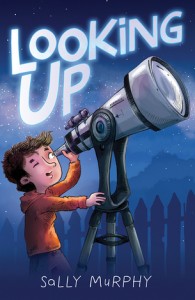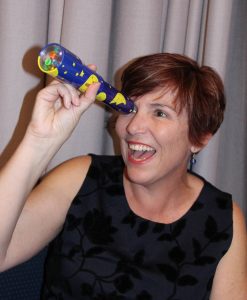In a new feature I’m planning on running regularly here on my website, I am matching my books with curriculum links. Each week I will feature one of my books, with curriculum links for a particular year group and ideas for how that book can be used to address them. If there’s a particular book or year group or curriculum area you’d like to see covered, drop me a line and I will see what I can do. First up, I’m featuring one of my newest books, Looking Up. Here goes:
Using Looking Up in a Year Three Classroom
Looking Up, by Sally Murphy, with illustrations by Aska 
Published by Fremantle Press, 2017
ISBN 9781925164572
Format, Paperback 72 pages, RRP $14.99
Available from good bookstores or here. Also available as an ebook.
Blurb: Pete is hoping – desperately hoping – for a telescope. There’s nothing he wants more for his birthday. But when a mysterious card arrives in the mall, what Pete wants is turned upside down.
Sample Chapter HERE
Publisher’s Teacher Notes HERE
Sally’s Recommended Grade Levels: Year 2-6, but these suggestions focus on Year 3
Themes/Topics:
- Grandparents
- Family
- Stars
- Astronomy
- Telescopes
- Family
- Forgiveness
- Friendship
- Empathy
- Mysteries
- Birthdays
Curriculum Links:
Year 3 English
- Understand how different types of texts vary in use of language choices, depending on their purpose and context (for example, tense and types of sentences) (ACELA1478)
- Understand that verbs represent different processes, for example doing, thinking, saying, and relating and that these processes are anchored in time through tense (ACELA1482 )
Chapter Two
In groups, identify the verbs used in this chapter. Use different colours to identify each of doing, thinking, saying and relating. As class brainstorm to build a word bank of verbs – for example ‘Listening”’ (p. ) could lead to ‘hearing’. In groups, or individually, have students change selected verbs to past tense and/or future tense.
Writing: Rewrite a scene in present tense. How did the language change? Which did students prefer?
Rewrite the same scene as a news report. How did the language change? Was it more formal? Did it require additional information? Were some parts of the scene left out?
Compare the language and sentence structure of the original scene with that of a news report. Look at differences in sentence complexity, language choice etc.
- Draw connections between personal experiences and the worlds of texts, and share responses with others (ACELT1596)
Before reading, discussion questions can focus on children’s experiences with grandparents or great-grandparents, as well as on birthdays, wishlists and receiving mail.:
- How many grandparents do you have?
- Do any of them live far away?
- Do you have grandparents you have never met?
- What is your favourite memory with a grandparent?
- What’s the favourite birthday/Christmas/other present you have received?
- What kind of letters does the postman/postwoman deliver?
- Have you ever received a letter addressed to you?
During reading
Chapter Two –p. 11 stop and have students guess what might be in the envelope
p. 14 After he removes the card, but before we find out who it is from, have students’ make predictions.
After Reading the Chapter:
Discuss: Why might Pete not know he has a grandfather?
Chapter 9
- p. 58 Stop at the arrow. Make predictions. Will Pete get the telescope? Why/why not.
After the chapter:
- How do students feel about Pete not getting the telescope – and his reaction?
- Have they ever not got something that they really wanted?
Writing suggestions:
- Write a recount of a visit to a grandparent, or a favourite birthday memory.
- Write a wishlist of things students would like to receive for their next birthday/Christmas. Then use the internet or catalogues to work out how much their list might cost.
- Develop criteria for establishing personal preferences for literature (ACELT1598)
Before reading: Looking at the cover, have students predict whether or not they will enjoy this book. Why/why not? In writing books, have them write their predictions regarding enjoyment of the text
During Reading: After each reading session, discuss students’ reactions to the text. Are they enjoying it? DO they think that what happened is interesting/scary/boring? Are they keen to know what will happen next? How do they feel about Pete? Mum? Grandad?
After Reading: Discuss students’ reactions to the ending. In writing books, write about their responses to the book and how these differ from their feelings before.
Extension: Write a book review. (For examples, see www.aussiereviews.com)
- Identify the point of view in a text and suggest alternative points of view (ACELY1675)
During reading:
- After Chapters 4, 6 and 8, discuss Pete’s reactions to these events, and how Mum would be feeling. Draw a picture of Mum (or teacher can provide) with thought bubbles for what Mum might be thinking but not saying.
- After Chapter 5, discuss how it might be for Grandad to meet Pete for the first time. What is he thinking and feeling?
Writing: Rewrite one of these scenes from the point of view of the other character.
Other suggestions for using Looking Up in your classroom include:

Make birthday/Christmas cards
Make origami stars – instructions here.
Make a Constellation Projector like this one here.
Email the author (that’s me!) Your students can write to me through this website, and share their responses or ask questions.
Related Books
Featuring Grandparents
Pearl Verses the World, by Sally Murphy
Grandpa and Thomas, by Pamela Allen
Granny Grommet and Me, by Dianne Wolfer and Karen Blair
Love From Grandma, by Jane Tanner
Mostly, I’d love to remind you that while I love to see my books used in classrooms, I also love to see kids just enjoying them. Reading a book should be pleasurable – whether it’s being used in the classroom or not. So have fun with Looking Up!
I’d love to know if you found these notes useful, or if you have any other suggestions, or if there’s a different book you’d love to see featured in this way. Leave a comment!
[…] ideas for using Looking Up, can be found here or […]